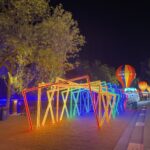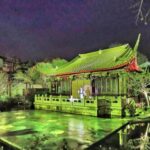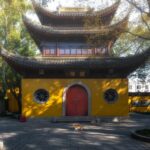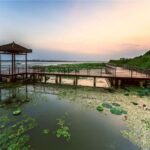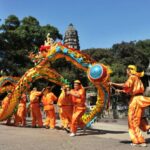Huanyiu Mountain Villa, also known as Yiyuan, is located in the Embroidery Museum. It is a classical garden mainly featuring rockeries. It is dominated by mountains, supplemented by a pond, and there are not many buildings. Although the garden is small, it is extremely imposing. The layout is cleverly and appropriately designed, integrating lakes, mountains, ponds, trees, and buildings. A rockery and a bay of water are particularly ingenious.
Rockery: Huanyiu Mountain Villa is listed as a famous garden in Suzhou mainly because of its rockery. The lake stone rockery in the garden was built by Ge Yuliang, a famous rockery builder in the Qianlong period of the Qing Dynasty. Ge’s rockery building is truly remarkable. Occupying less than half an acre, yet within a short distance, there are countless peaks and valleys. Looking around the mountains, the scenery changes with every step, and it has the reputation of being ‘unparalleled in Jiangnan’.

Feixue Spring: A famous spring in Suzhou gardens. During the Qianlong period of the Qing Dynasty, Jiang Ji (courtesy name Jichuan), a deputy chief of the Ministry of Punishments, purchased Huanyiu Mountain Villa and renovated it. He dug the ground and found this spring. The water quality is excellent. Jiang Ji named it ‘Feixue Spring’ based on the meaning of ‘Fine pearls fall from the grinding mill, swirling around the cup, snowflakes fly lightly’ in Su Dongpo’s poem about making tea in the examination hall. Now, on the autumn mountain on the west side of the garden, the two characters ‘Feixue’ can be seen engraved on the stone wall by the pond.

At the end of the mountain path, the waterfront rock juts out and disappears with the water waves, full of natural charm. In addition, there is a small pavilion behind the rockery, adjacent to the mountain and facing the water. Beside it is a small cliff and stone pool. Borrowing the meaning of ‘White rapids and green pools, with clear reflections on all sides’, it is named ‘Half Pool of Autumn Water and One Mountain House’. Looking at the mountains from the pavilion, the rocky cliffs are like paintings.

The surrounding forest is shady and clear, with gnarled branches and trunks, full of wild charm. Going out of the pavilion to the north and going down along the stone steps, the mountain stream flows low and the peak stones are uneven. There is a road leading to the ‘Buqiu Fang’ in the north of the garden. The south side of the boat faces the water. This building has three bays in width and echoes the large hall on the south side of the pool from afar.
Opening hours: Open from 07:30 to 17:30 from March 1st to October 31st; open from 07:30 to 17:00 from November 1st to February 28th. Preferential policies: Children: Those under 6 years old (inclusive) or under 1.4 meters in height can enter for free with valid identity documents. Minors: Those aged 6 years old (exclusive) to 18 years old (inclusive) can enjoy half price with valid identity documents. Elderly: Those aged 70 years old (inclusive) and above can enter for free with valid identity documents. Those aged 60 years old (inclusive) to 70 years old (exclusive) can enjoy half price with valid identity documents. Students: Full-time undergraduate and below students can enjoy half price. Military personnel: Active servicemen of the People’s Republic of China and retired military cadres can enter for free with valid identity documents. Disabled people: Disabled people and one accompanying person of severely disabled people can enter for free with valid identity documents. Preferential objects: Preferential objects with the ‘Preferential Certificate for Veterans of the People’s Republic of China’ and the ‘Preferential Certificate for Martyrs of the People’s Republic of China, Servicemen Died in the Line of Duty, and Dependents of Servicemen Died of Illnesses’ (except for the inner gardens, paid items in the park and night tour projects) can enter for free. Suzhou medical staff: Within seven days from International Nurses Day on May 12 and Chinese Doctors’ Day on August 19 every year (from May 12 to 18 and from August 19 to 25), Suzhou medical staff can visit scenic spots for free. When Suzhou medical staff visit scenic spots, please show ‘personal ID card’ + ‘Suzhou medical staff free park card (electronic card)’, and they can enter the park directly without reservation and be exempted from the first entrance ticket fee. Supplementary note: The above information is for reference only. The specific information is subject to the publicity of the scenic spot. Historical evolution: The construction history of Huánxiù Mountain Villa can be traced back to the Jin Dynasty when brothers Wang Xun donated their houses to build Jingde Temple. Later, it became the Jingu Garden of Qian Yuanliao, the son of Qian Liu, the king of Wuyue in the Five Dynasties. In the Song Dynasty, it was the medicinal garden of the writer Zhu Changwen. Since then, it has experienced many rises and falls. During the Jiajing period of the Ming Dynasty, it was successively changed into Xuedao Academy and the Grain Supervision Department. During the Wanli period, it was the residence of Grand Secretary Shen Shixing. At the end of the Ming Dynasty and the beginning of the Qing Dynasty, Shen Jikui, a descendant, built Quyuan Garden. During the Qianlong period of the Qing Dynasty, it was the residence of Jiang Ji, a deputy director of the Ministry of Punishments. Jiang built the ‘Qiuzilou’ and piled up rocks behind the building to form a mountain. After digging three feet deep, there was a clear spring flowing and gathering into a pool. The spring was named ‘Flying Snow’, and houses and pavilions were built among them. Later, it successively became the residence of Bi Yuan, a minister, and Sun Shiyi, a grand secretary. Sun Jun, a descendant of Sun, has the elegant name of Linquan. In the twelfth year of Jiaqing, he invited Ge Yuliang, a famous rockery builder, to reconstruct this garden.Guo Yuliang, on a plot of land just half a mu, created a rockery that captured the essence of a thousand miles in a single foot, henceforth making the garden famous for its artificial mountains. In the 29th year of the Daoguang era (AD 1847), Wang Weiren purchased and built the Wang family’s ancestral hall, established the Geng Yin Yi Zhuang, and renovated the northeastern garden. This garden became part of the Wang family’s ancestral hall, known as ‘Geng Yun Mountain Villa’, and was renamed ‘Huanxiu Mountain Villa’, also referred to as ‘Yi Garden’.
Over time, much of it was destroyed, and by 1949, only one mountain, one pond, and a pavilion named ‘Bu Qiu Fang’ remained. From June 1984 to October 1985, the Suzhou Garden Bureau and the Embroidery Research Institute jointly funded a large-scale restoration. The main features restored included the Huanxiu Mountain Villa’s Four-Sided Hall, Yougu Hall, Wenquan Pavilion, and the Side Building.